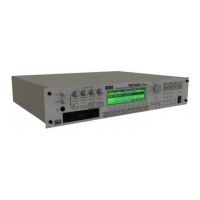41
Basic functions
Saving data
1) Make sure that you have a sufficient number of
floppy disks, and press the [F8] (“OK”) key. Sav-
ing will begin.
2) When the disk is full, the following dialog box
will appear.
3) Insert the next floppy disk into the TRITON-
Rack’s floppy disk drive.
4) Press a function key etc. to make the TRITON-
Rack detect the next floppy disk.
5) Press the [F8] (“Select”) key. Saving will begin.
6) If the “No Space available on medium” dialog
box appears again, repeat steps 1)–5).
If you decide to cancel the Save operation, press
the [F7] (“Cancel”) key.
The dialog box of step 2) will appear. Press the
[F7] (“Cancel”) key will appear.
The display will ask “Are you sure?” Press the
[F8] (“OK”) key. This will cancel the Save opera-
tion.
7) When saving is complete, you will return to the
Save page.
0 When saving ends and you return to the Save
page, the LCD screen will show the file that was
saved.
The data will be saved as the following files.
.PCG file
Programs, combinations, drum kits, user arpeggio
patterns, and global settings that were saved in
internal memory
.SNG file
Multi and user patterns
.KSC file
A file which lists the multisamples and samples
used
Directory
A directory containing the multisamples (.KMP
files) and samples (.KSF files) that are listed in the
.KSC file
When loading files that were saved across multiple
volumes of media, a “Where is a ...” dialog box will
appear during the loading process. Insert the disk
containing the specified file, select the directory,
and press the [F8] (“Select”) key to load the data.
(
☞PG p.125)
Other ways to save
In addition to “Save All,” the Utility menu commands
include “Save PCG” which saves programs, combina-
tions, drum kits, user arpeggio patterns, and global set-
tings; “Save Multi” which saves only multi and user
patterns; and “Save Sampling Data” which saves only
multisamples and samples. Select the appropriate Util-
ity menu command for the data that you wish to save
on external media.
When using “Save All,” “Save PCG & Multi,” and
“Save PCG” to save combinations, you should also
remember to save the programs used by each tim-
bre (and the drum kits used by the programs) and
user arpeggio patterns at the same time.
Similarly when saving programs, you should also
remember to save the drum kits and user arpeggio
patterns used by the programs.
If your programs or drum kits use multisamples
and samples that were created in Sampling mode,
we recommend that you use “Save All” to save the
data.
When you use “Save PCG” or “Save Sampling
Data” to individually save a program or drum kit,
or a multisample or sample that you created in
Sampling mode, we recommend that you save
them under the same filename in the same direc-
tory.
When you use “Load PCG” to load a .PCG file, the
identically-named .KSC file will also be loaded so
that the correct multisamples/samples will corre-
spond automatically.
MIDI data dump
The programs (I-A–I-F, E-A–E-H)), combinations (I-A–
I-E, E-A–E-H), drum kits, arpeggio patterns and global
settings of internal memory, and multi and user arpeg-
gio patterns can be transmitted as MIDI exclusive data
and saved on a connected MIDI data filer, computer, or
another TRITON-Rack. (
☞PG p.113)

